Before attempting any of the projects in our project section, it is very important to be equipped with some basic information to be successful. This is why: In this tutorial, we’re going to be looking at how electricity works.
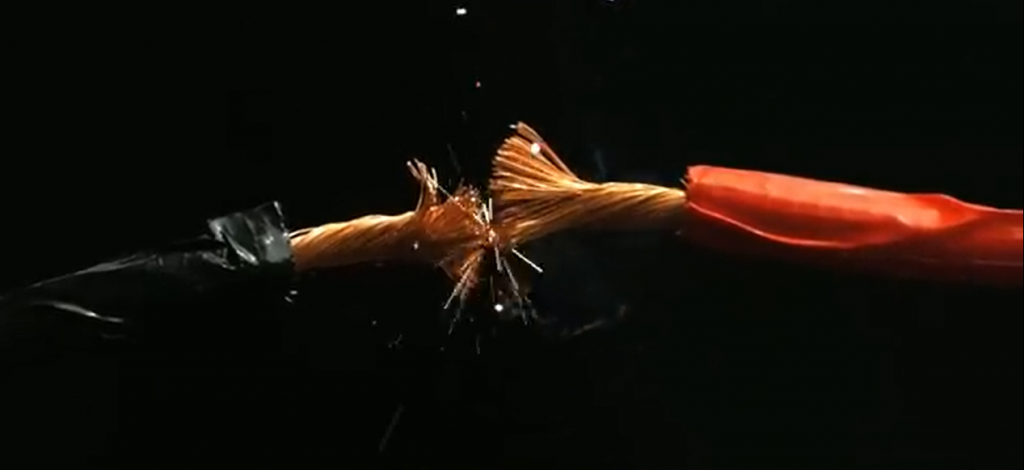
Now this is pretty essential knowledge for any engineer, so we’ll go through the basic parts of what you need to know. So let’s start at the very basics, and for that we need to take a look at the atom. Everything, including you, is made from atoms. All the materials we use are made from atoms. The materials are just different because the construction of their atoms is slightly different.
Atom
Atoms are made from three particles, two of which are found inside the nucleus, and the third particle sits outside this. At the center of the atom, we have the nucleus. Inside the nucleus we have the neutrons, which have no charge, and we also have the protons, which are positively charged. The neutrons and the protons are much heavier than the electrons, so these will stay within the nucleus, and surrounding the nucleus are different layers of orbital shells. 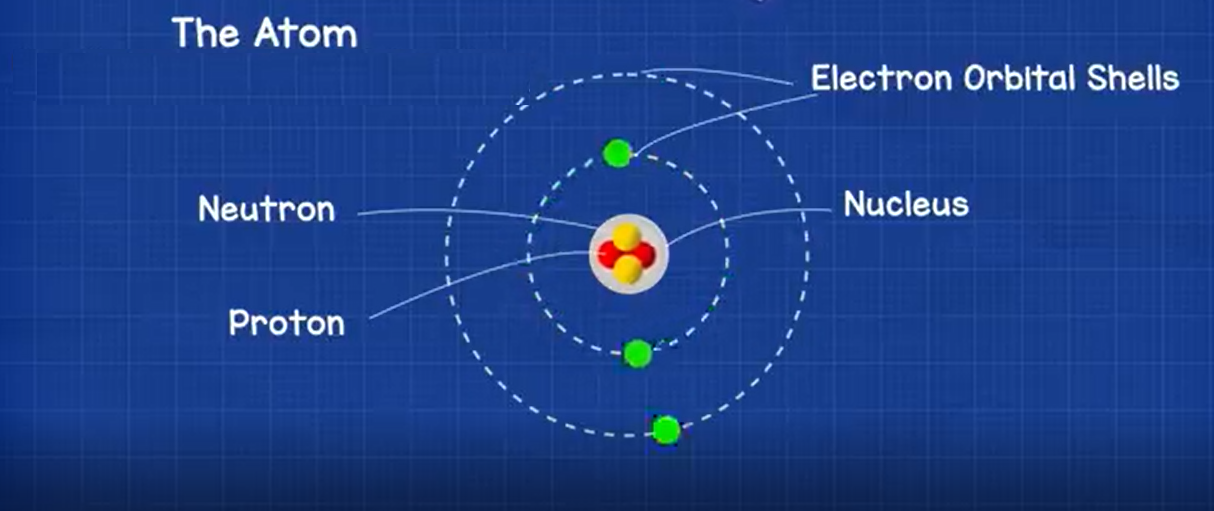 These are like flight paths for the electrons. The electrons flow along these flight paths much like a satellite orbits our planet, except that the electrons travel at almost the speed of light. The electrons are negatively charged, and they are attracted to the positive charge of the protons. The electrons orbit around the nucleus in these orbital shells, and there is a set number of how many electrons can be in any orbital shell.
These are like flight paths for the electrons. The electrons flow along these flight paths much like a satellite orbits our planet, except that the electrons travel at almost the speed of light. The electrons are negatively charged, and they are attracted to the positive charge of the protons. The electrons orbit around the nucleus in these orbital shells, and there is a set number of how many electrons can be in any orbital shell.
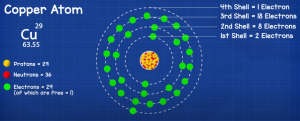 The number of protons, neutrons, and electrons an atom has tells us which material it is. You can see the Copper Atom in the picture.
The number of protons, neutrons, and electrons an atom has tells us which material it is. You can see the Copper Atom in the picture.
Conductors and Insulators
Atoms hold on to their electrons very tightly, but some materials will hold on to them more tightly than others. The outermost shell in the picture is known as the valence shell, and in this shell some materials have loosely bound electrons that can flow to other atoms. Atoms that can pass electrons are called conductors,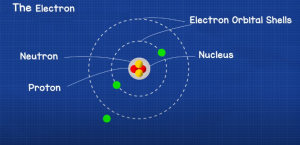 and most metals are conductors. On the other hand, atoms that do not have free electrons and so cannot pass electrons between other atoms are known as insulators, and these are things like glass and rubber.
and most metals are conductors. On the other hand, atoms that do not have free electrons and so cannot pass electrons between other atoms are known as insulators, and these are things like glass and rubber.
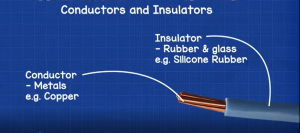 We can combine these materials to safely use electricity by having the conductor in the center, which allows electrons to move, but surrounding this with an insulator to restrict where they can flow to and not into us, which keeps us safe.
We can combine these materials to safely use electricity by having the conductor in the center, which allows electrons to move, but surrounding this with an insulator to restrict where they can flow to and not into us, which keeps us safe.
Copper Wire Slice
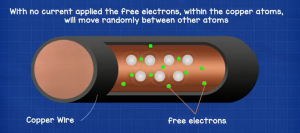 If we look inside the slice of copper cable, we see free electrons surrounding the nucleus of the copper atom, and these free electrons are able to move to other atoms. But this happens randomly in any direction.
If we look inside the slice of copper cable, we see free electrons surrounding the nucleus of the copper atom, and these free electrons are able to move to other atoms. But this happens randomly in any direction.
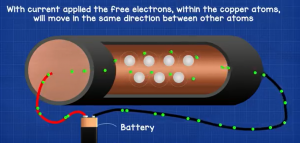 If we then connect the slice of copper cable to close the circuit with a power source such as a battery, then the voltage will force the electrons to move, and they will then all flow in the same direction to try and get back to the other terminal of the battery.
If we then connect the slice of copper cable to close the circuit with a power source such as a battery, then the voltage will force the electrons to move, and they will then all flow in the same direction to try and get back to the other terminal of the battery.
Closed and Open Circuit
When we say circuit, this just means the route that electrons can flow along between the two terminals, the positive and the negative, of the power source. We can add things into the electron path like light bulbs, and 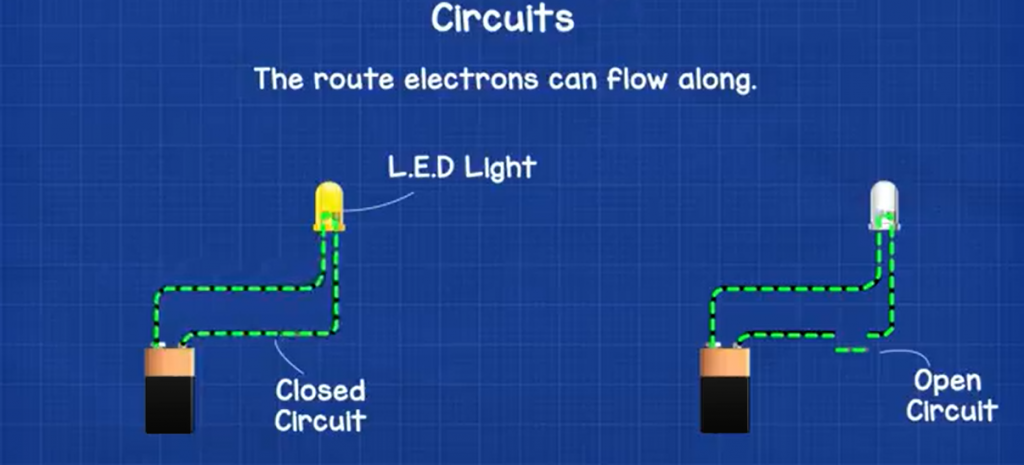 this means that the electrons will have to pass through this in order to get back to the other terminal, and so we can use this to create things such as light. The circuit can either be open or closed. In a closed circuit, that means the electrons can flow around, and in an open circuit, this means that the electrons are not able to flow.
this means that the electrons will have to pass through this in order to get back to the other terminal, and so we can use this to create things such as light. The circuit can either be open or closed. In a closed circuit, that means the electrons can flow around, and in an open circuit, this means that the electrons are not able to flow.
Voltage
Voltage is a pushing force of electrons within a circuit. It’s like pressure in a water pipe. The more pressure you have, the more water can flow. The more voltage you have, the more electrons can flow. But what does a volt mean?  Well, a volt is a joule per coulomb, and a joule is a measurement of energy or work, and a coulomb is a group of flowing electrons. We’ll look at that in the next explanation. So, a 9-volt battery can provide 9 joules of energy in the form of work or heat per group of electrons that flow from one side of the battery to the other. In this case, the current flows from one side of the battery through the LED light bulb, which produces light, and then the electrons flow to the other side of the battery. Therefore, 9 joules of light and heat is produced by the light bulb.
Well, a volt is a joule per coulomb, and a joule is a measurement of energy or work, and a coulomb is a group of flowing electrons. We’ll look at that in the next explanation. So, a 9-volt battery can provide 9 joules of energy in the form of work or heat per group of electrons that flow from one side of the battery to the other. In this case, the current flows from one side of the battery through the LED light bulb, which produces light, and then the electrons flow to the other side of the battery. Therefore, 9 joules of light and heat is produced by the light bulb.
Current
 Current is the flow of electrons when a circuit is closed, and when the circuit is open, no electrons will flow. We can measure the flow of electrons just like you can measure the flow of water through a pipe to measure the flow of electrons, we use the unit of amps One amp means one coulomb per second, and one coulomb is a group of electrons. The group is incredibly large and is approximately 6.24 trillion trillion electrons, and that has to pass in one second for each to equal 1 amp. That’s why electrons are grouped together and just called amps to make it easier for engineers.
Current is the flow of electrons when a circuit is closed, and when the circuit is open, no electrons will flow. We can measure the flow of electrons just like you can measure the flow of water through a pipe to measure the flow of electrons, we use the unit of amps One amp means one coulomb per second, and one coulomb is a group of electrons. The group is incredibly large and is approximately 6.24 trillion trillion electrons, and that has to pass in one second for each to equal 1 amp. That’s why electrons are grouped together and just called amps to make it easier for engineers.
Resistance
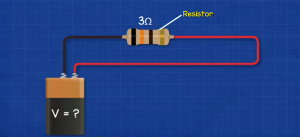 Resistance is a restriction to the flow of electrons in a circuit; the wire that carries electrons will naturally have some resistance. The longer the wire, the greater the resistance; the thicker the wire, the lower the resistance. The resistance to the flow of electrons is different for each material, and the temperature of the material can also change resistance to the flow of electrons. Electrical circuits use specially designed components known as resistors to purposely resist the flow of electrons. This is either to protect other components from too many electrons flowing through them. Resistance occurs when electrons collide with atoms; the amount of collisions is different from one material to another. Copper has a very low collision rate, but other materials such as iron have much more collisions. When collisions occur, atoms generate heat, and at a certain temperature the material will then start to produce light.
Resistance is a restriction to the flow of electrons in a circuit; the wire that carries electrons will naturally have some resistance. The longer the wire, the greater the resistance; the thicker the wire, the lower the resistance. The resistance to the flow of electrons is different for each material, and the temperature of the material can also change resistance to the flow of electrons. Electrical circuits use specially designed components known as resistors to purposely resist the flow of electrons. This is either to protect other components from too many electrons flowing through them. Resistance occurs when electrons collide with atoms; the amount of collisions is different from one material to another. Copper has a very low collision rate, but other materials such as iron have much more collisions. When collisions occur, atoms generate heat, and at a certain temperature the material will then start to produce light.
AC and DC Current
There are two types of current in electricity: alternating current, or AC and direct current DC. The two types of currents are represented by the symbols ![]() and direct current, or DC
and direct current, or DC![]() . Alternating current simply means that the current flows backwards and forwards in a circuit, like the terminals are constantly reversed. Alternating current is the most common source of power provided by the grid , but we will have to look at AC and DC in greater detail in the next parts of our electronic courses.
. Alternating current simply means that the current flows backwards and forwards in a circuit, like the terminals are constantly reversed. Alternating current is the most common source of power provided by the grid , but we will have to look at AC and DC in greater detail in the next parts of our electronic courses.
